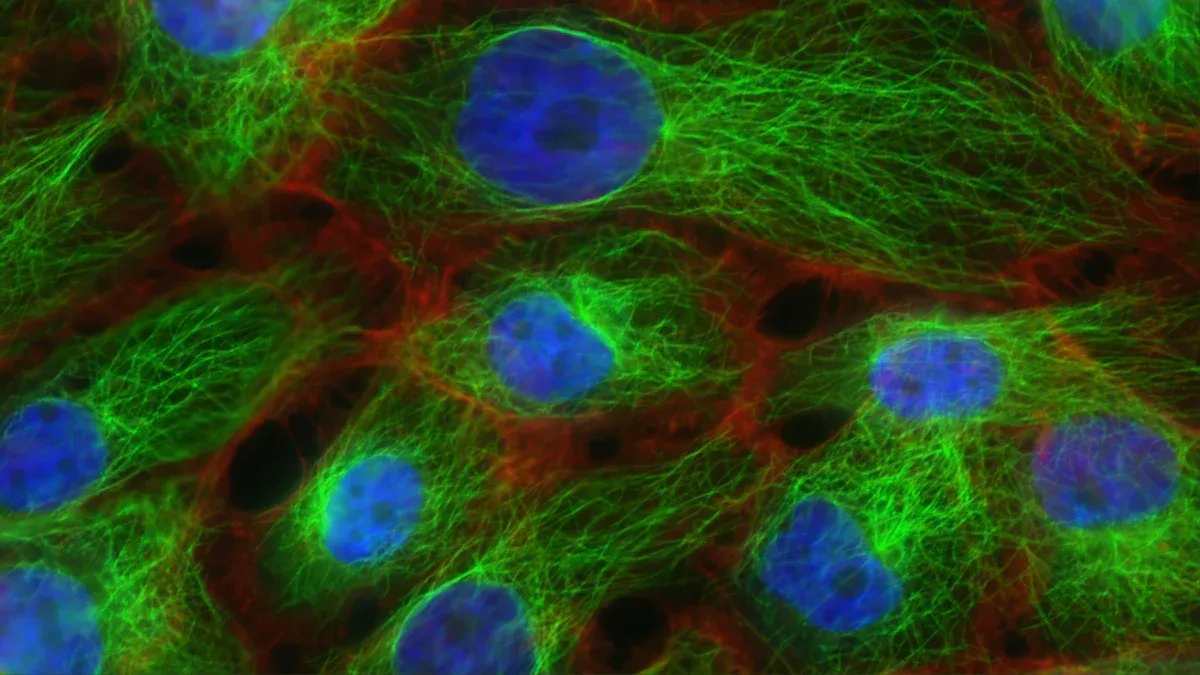What Is Invasive Ductal Carcinoma and Its Symptoms

Invasive ductal carcinoma is the most common type of breast cancer, accounting for 70 to 80% of all cases. It begins in the milk ducts, where breast milk flows, and spreads to nearby breast tissue. From there, it can enter the bloodstream or lymphatic system, potentially affecting other parts of your body. Recognizing its symptoms early can make a significant difference in treatment outcomes. Paying attention to changes in your breast health is essential for early detection and timely medical care.
Key Takeaways
Invasive ductal carcinoma is the most common breast cancer type. Early detection is very important for good treatment results.
Checking your breasts often can help find lumps or changes. These are main signs of invasive ductal carcinoma.
Knowing risks like age and family history helps you stay aware. This can remind you to get regular check-ups.
Finding cancer early makes survival chances much higher. Localized cancer has a 99% five-year survival rate.
Staying healthy by exercising and drinking less alcohol lowers your risk of this cancer.
Symptoms of Invasive Ductal Carcinoma

Common Symptoms
Lump or thickening in the breast or underarm
One of the earliest signs of invasive ductal carcinoma is a new lump or thickened area in your breast or underarm. This lump often feels firm and painless, making it easy to overlook. Regular self-examinations can help you detect these changes early.
Changes in breast size or shape
You might notice that one breast appears larger or has an unusual shape compared to the other. Swelling in part or all of the breast can also occur. These changes may not always be painful but should prompt you to seek medical advice.
Nipple discharge, especially if bloody
Unusual nipple discharge, particularly if it contains blood, is another common symptom. This discharge may occur without any squeezing or stimulation. Pay attention to any changes in the color or consistency of the fluid.
Less Common Symptoms
Skin dimpling or puckering
In some cases, the skin on your breast may develop dimples or appear puckered, resembling the texture of an orange peel. This change often indicates underlying tissue changes caused by invasive ductal carcinoma.
Redness or scaling of the nipple or breast skin
Red, scaly patches on your nipple or breast skin can signal inflammation or irritation. These symptoms may mimic a rash but should not be ignored, especially if they persist.
Pain in the breast or nipple area
Although breast cancer is often painless, some individuals experience discomfort or tenderness in the affected area. This pain may feel localized or radiate across the breast.
Note: Symptoms like coughing, bone pain, or neurological issues may arise if the cancer spreads to other parts of your body. Early detection remains crucial for effective treatment.
Causes and Risk Factors of Invasive Ductal Carcinoma
Understanding the causes and risk factors of invasive ductal carcinoma can help you assess your risk and take preventive measures where possible. These risk factors fall into two categories: nonmodifiable and modifiable.
Nonmodifiable Risk Factors
Some risk factors are beyond your control. These include:
Age: Most cases occur in individuals over the age of 55.
Gender: Women are nearly 100 times more likely to develop invasive ductal carcinoma than men.
Family history: Having a first-degree relative (like a parent or sibling) with breast or ovarian cancer increases your risk.
Genetic mutations: Mutations in genes like BRCA1 and BRCA2 significantly elevate your risk. These genes normally help repair damaged DNA, but mutations impair this process, making cancer more likely.
Dense breast tissue: Dense tissue can make it harder to detect abnormalities during screenings.
Previous radiation therapy: Radiation to the chest area, especially at a young age, raises your risk.
While you cannot change these factors, being aware of them can encourage you to prioritize regular screenings and consultations with your doctor.
Modifiable Risk Factors
Certain lifestyle choices and behaviors can influence your risk of developing invasive ductal carcinoma. These include:
Hormone replacement therapy
Using hormone replacement therapy (HRT), especially for extended periods, can increase your risk. If you are considering HRT, discuss the potential risks and benefits with your healthcare provider.
Alcohol consumption
Drinking alcohol regularly raises your risk of breast cancer. Even moderate consumption can have an impact. Limiting your intake or avoiding alcohol altogether can help reduce this risk.
Obesity and lack of physical activity
Excess body weight, particularly after menopause, is linked to a higher risk of invasive ductal carcinoma. Staying active and maintaining a healthy weight can lower your risk. Aim for regular exercise and a balanced diet to support your overall health.
By addressing these modifiable factors, you can take proactive steps to reduce your risk and improve your overall well-being.
Diagnosis of Invasive Ductal Carcinoma
Screening and Imaging Tests
Mammogram
A mammogram is one of the most common imaging tests used to detect invasive ductal carcinoma. It uses low-dose X-rays to create detailed images of your breast tissue. This test can reveal abnormalities like masses or calcifications, even before symptoms appear. Regular mammograms are essential for early detection, especially if you are over 40 or have a higher risk due to family history.
Ultrasound
Ultrasound uses sound waves to produce images of the inside of your breast. It helps distinguish between solid masses and fluid-filled cysts. If a mammogram detects an abnormality, your doctor may recommend an ultrasound for further evaluation. This test is particularly useful for individuals with dense breast tissue, where mammograms may not provide clear results.
Confirmatory Tests
Biopsy
A biopsy is the gold standard for confirming invasive ductal carcinoma. During this procedure, your doctor removes a small sample of breast tissue for examination under a microscope. This test determines whether the cells are cancerous and identifies the type of breast cancer. Biopsies provide definitive answers, helping guide your treatment plan.
MRI
Magnetic resonance imaging (MRI) offers a more detailed view of your breast tissue. It is especially valuable for assessing the extent of the disease and detecting invasive components in cases initially diagnosed as ductal carcinoma in situ (DCIS). MRI can also reveal hidden invasive characteristics, such as irregularly shaped masses or areas of non-mass enhancement, which may not appear on other imaging tests.
Biopsy confirms the presence of invasive ductal carcinoma by analyzing tissue samples.
MRI predicts the likelihood of invasive components and evaluates the disease's extent.
MRI features like heterogeneous enhancement and irregular masses often indicate a higher risk of invasive cancer.
Staging and Grading
TNM Staging System
Doctors use the TNM staging system to classify invasive ductal carcinoma. This system evaluates three key factors:
Category | Description |
|---|---|
Primary tumor (T) | Size and extent of the tumor. |
Regional lymph nodes (N) | Involvement of nearby lymph nodes. |
Distant metastasis (M) | Spread to distant organs or tissues. |
Hormone Receptor and HER2 Status
Your doctor will also assess the hormone receptor and HER2 status of the tumor. These tests determine whether the cancer cells rely on hormones like estrogen or progesterone to grow. HER2 testing identifies whether the tumor produces excess HER2 protein, which can influence treatment options. Knowing these details helps tailor your treatment plan for the best possible outcome.
Treatment Options for Invasive Ductal Carcinoma

Surgery
Surgery is often the first step in treating invasive ductal carcinoma. The type of surgery depends on the tumor's size, location, and your preferences. Below are the two most common surgical options:
Surgical Option | Description |
|---|---|
Lumpectomy | Removes the tumor and a small margin of surrounding tissue. Often followed by radiation therapy to reduce recurrence risk. |
Mastectomy | Removes the entire breast. This option is typically chosen for larger tumors or multiple tumors. Types include total simple, skin-sparing, and modified radical mastectomy. |
Your doctor will help you decide which surgical approach is best for your situation.
Radiation Therapy
Radiation therapy uses high-energy rays to target and destroy cancer cells. It is often recommended after surgery to eliminate any remaining cancerous cells.
External Beam Radiation
External beam radiation (EBRT) is the most common form of radiation therapy. It directs radiation beams at the affected area from outside the body. EBRT has a low risk of subsequent mastectomy (1.3%) and a lower incidence of fat necrosis (7.7%) compared to other methods.
Brachytherapy
Brachytherapy involves placing radioactive material inside the breast near the tumor site. This method reduces the risk of subsequent mastectomy (2.8%) but has a higher chance of postoperative infection (16.5%) and breast pain (22.9%).
Systemic Therapies
Systemic therapies treat invasive ductal carcinoma by targeting cancer cells throughout your body. These therapies include:
Chemotherapy
Chemotherapy uses drugs to kill rapidly dividing cancer cells. It is often used before or after surgery to shrink tumors or prevent recurrence.
Hormone Therapy
Hormone therapy blocks hormones like estrogen or progesterone that fuel cancer growth. This treatment is effective for hormone receptor-positive cancers.
Targeted Therapy
Targeted therapies, such as HER2 inhibitors, focus on specific proteins in cancer cells. These therapies:
Target HER2 proteins to slow or stop cancer cell growth.
Avoid harming healthy cells, unlike chemotherapy.
Provide a more precise treatment option for HER2-positive cancers.
Tip: New advancements in targeted therapies continue to improve outcomes for patients with invasive ductal carcinoma.
Prognosis and Survival Rates for Invasive Ductal Carcinoma
Factors Influencing Prognosis
Stage at diagnosis
The stage at which invasive ductal carcinoma is diagnosed plays a critical role in determining your prognosis. Early-stage detection often leads to better outcomes. For example, localized cancer, which remains confined to the breast, has a five-year survival rate of 99%. Regional cancer, which spreads to nearby tissues or lymph nodes, has a survival rate of 86%. Distant cancer, which spreads to other parts of the body, has a significantly lower survival rate of 31%.
Stage | 5-year relative survival rate |
|---|---|
Localized | 99% |
Regional | 86% |
Distant | 31% |
This data highlights the importance of early detection and regular screenings. Identifying cancer at an earlier stage can significantly improve your chances of successful treatment.
Tumor grade and hormone receptor status
The tumor grade and hormone receptor status also influence your prognosis. Tumor grade refers to how abnormal the cancer cells look under a microscope. Lower-grade tumors grow more slowly and have a better prognosis. Hormone receptor-positive tumors, which rely on hormones like estrogen or progesterone to grow, often respond well to hormone therapy. HER2-positive tumors, while more aggressive, can be treated effectively with targeted therapies.
Survival Statistics
Five-year survival rates by stage
Survival rates vary depending on the stage of invasive ductal carcinoma at diagnosis:
99% for localized cancer.
86% for regional cancer.
31% for distant cancer.
These statistics emphasize the importance of catching the disease early.
Impact of early detection on outcomes
Early detection significantly improves survival rates. Regular mammograms and self-examinations can help you identify changes in your breast health. When invasive ductal carcinoma is caught early, treatment options are more effective, and the likelihood of long-term survival increases.
Tip: Stay proactive about your breast health. Early detection can save lives.
Invasive ductal carcinoma is a serious condition, but understanding its symptoms, causes, and treatment options can empower you to take control of your health. Early detection plays a vital role in improving outcomes. Regular screenings, such as mammograms, and paying attention to changes in your breast health can make a significant difference. If you notice any unusual symptoms or have concerns, consult a healthcare provider promptly. Taking proactive steps ensures you stay informed and receive the care you need.
FAQ
What is the difference between invasive ductal carcinoma and ductal carcinoma in situ (DCIS)?
Invasive ductal carcinoma spreads beyond the milk ducts into surrounding breast tissue. DCIS, on the other hand, remains confined to the milk ducts and does not invade nearby tissues. Early detection of DCIS can prevent progression to invasive cancer.
Can men develop invasive ductal carcinoma?
Yes, men can develop invasive ductal carcinoma, though it is rare. Male breast cancer accounts for less than 1% of all breast cancer cases. Symptoms in men include lumps, nipple discharge, or changes in breast skin.
How often should you get screened for breast cancer?
Doctors recommend annual mammograms starting at age 40 for most women. If you have a higher risk due to family history or genetic factors, your doctor may suggest earlier or more frequent screenings.
Is invasive ductal carcinoma curable?
Yes, early-stage invasive ductal carcinoma is often curable with appropriate treatment. Options like surgery, radiation, and systemic therapies improve outcomes. Early detection plays a key role in successful treatment.
What lifestyle changes can reduce your risk of invasive ductal carcinoma?
You can lower your risk by maintaining a healthy weight, exercising regularly, limiting alcohol intake, and avoiding hormone replacement therapy when possible. A balanced diet rich in fruits and vegetables also supports overall breast health.
Tip: Consult your doctor to create a personalized plan for reducing your risk.
See Also
Understanding Ductal Carcinoma In Situ And Its Signs
Exploring Endometrial Cancer And Its Common Symptoms
Defining Carcinoid Syndrome And Recognizing Its Symptoms
Identifying Symptoms And Causes Associated With Breast Cancer
